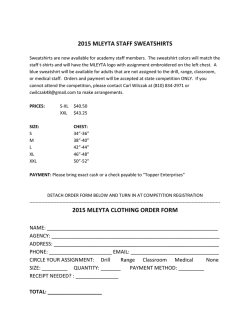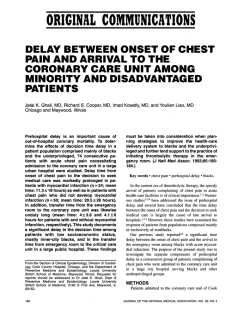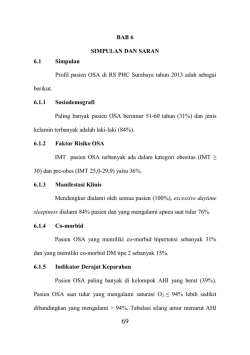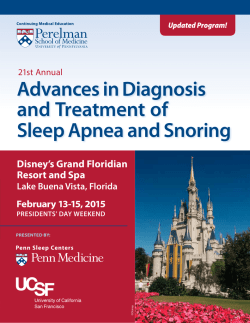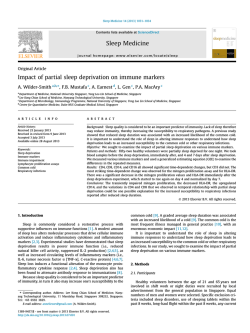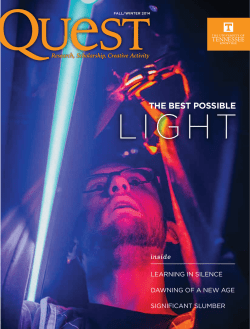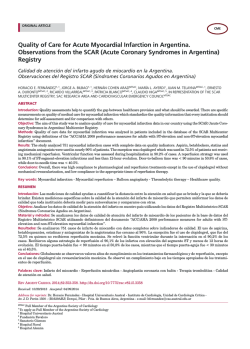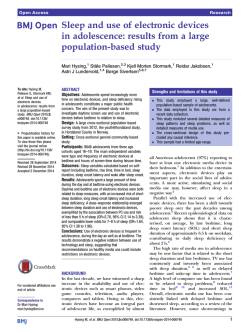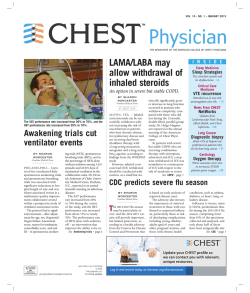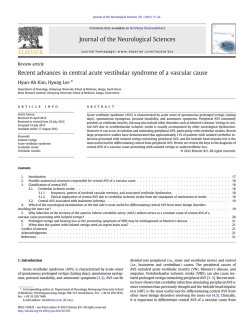
Response Factors That May Influence Apnea
has been done in trauma care, telemedicine approaches, and widespread training of hospital providers in the fundamentals of critical care support are some of the potential solutions for staffing shortage. Ognjen Gajic, MD, FCCP Bekele Afessa, MD, FCCP Rochester, MN Affiliations: Drs. Gajic and Afessa are affiliated with the Division of Pulmonary and Critical Care Medicine, Department of Internal Medicine, Mayo Clinic College of Medicine. Financial/nonfinancial disclosures: The authors have reported to the ACCP that no significant conflicts of interest exist with any companies/organizations whose products or services may be discussed in this article. Correspondence: Bekele Afessa, MD, FCCP, Division of Pulmonary and Critical Care, Mayo Clinic, 200 First St SW, Rochester MN 55905; e-mail: [email protected] © 2009 American College of Chest Physicians. Reproduction of this article is prohibited without written permission from the American College of Chest Physicians (www.chestjournal.org/site/ misc/reprints.xhtml). DOI: 10.1378/chest.09-1691 References 1 Gajic O, Afessa B. Physician staffing models and patient safety in the ICU. Chest 2009; 135:1038 –1044 2 Levin PD, Sprung CL. Intensive care triage: the hardest rationing decision of them all. Crit Care Med 2006; 34:1250 –1251 3 Simchen E, Sprung CL, Galai N, et al. Survival of critically ill patients hospitalized in and out of intensive care. Crit Care Med 2007; 35:449 – 457 4 Simchen E, Sprung CL, Galai N, et al. Survival of critically ill patients hospitalized in and out of intensive care units under paucity of intensive care unit beds. Crit Care Med 2004; 32:1654 –1661 Response “Whoever destroys the life of a single human being . . . it is as if he had destroyed an entire world; and whoever preserves the life of a single human being . . . it is as if he had preserved an entire world.” Talmud Sanhedrin 37a To the Editor: We thank Dijkema et al for their thoughtful letter on our recent editorial.1 We agree that the essential function of an ICU is to prolong meaningful patient survival in individuals with reversible critical illnesses, using high-technology care, but not to act as a substitute for end-of-life hospice care or as a way station for those patients with irreversible critical illness. It is clear that admissions to the ICU are overutilized in the United States compared with other developed countries such as Holland. The essential dilemma is about who makes the decision on ICU admission: the patients, their relatives, or ICU physicians. Several points are worth making: 1. The ICU is a triaged unit, meaning that scarce ICU resources should be used to help those patients who are likely to benefit from intensive care. 2. Death in the ICU is rarely a dignified death. 3. Death is an experience that we must all meet: death in an ICU is an entirely optional experience. 4. Demographic and health-care funding changes will force better utilization of ICU resources. 1444 Downloaded From: http://journal.publications.chestnet.org/ on 02/06/2015 5. Death and the process of dying is a cultural process as well as a health-care process. In summary, we agree with the positions of Dijkema et al. The expensive dilemma within which the United States finds itself is, of course, multifactorial. Nonetheless, better utilization of ICU admission and discharge policies toward realistic outcomes in meaningful survival remains an important, and often elusive, goal. Joseph G. Murphy, MD, FCCP William F. Dunn, MD, FCCP Rochester, MN Affiliations: Dr. Murphy is Professor of Medicine and Chair, Scientific Publications, and Dr. Dunn is Associate Professor of Medicine, Division of Pulmonary and Critical Care Medicine, Mayo Clinic. Financial/nonfinancial disclosures: The authors have reported to the ACCP that no significant conflicts of interest exist with any companies/organizations whose products or services may be discussed in this article. Correspondence to: Joseph G. Murphy, MD, FCCP, Mayo Clinic, Cardiology Division, 10 Plummer Building, Rochester, MN 55905; e-mail: [email protected] © 2009 American College of Chest Physicians. Reproduction of this article is prohibited without written permission from the American College of Chest Physicians (www.chestjournal.org/site/ misc/reprints.xhtml). DOI: 10.1378/chest.09-1897 Reference 1 Dunn W, Murphy J. Should intensive care medicine itself be on the critical list? Chest 2009; 135:892– 894 Factors That May Influence Apnea-Hypopnea Index in Patients With Acute Myocardial Infarction To the Editor: In a recent issue of CHEST (June 2009), Lee et al1 reported a very high prevalence of obstructive sleep apnea (OSA) [65.7%] in patients with acute myocardial infarction (AMI) despite using an apnea-hypopnea index (AHI) value of ⱖ 15 events per hour as being diagnostic of OSA. This prevalence is higher than that reported in previous studies,2– 4 which used a lower AHI cutoff of 10 events per hour. The authors attributed this discrepancy to a number of factors, including differences in the timing of sleep studies and the characteristics of the studied population, which included a heterogeneous group of patients. In a previous study,2 using level II, comprehensive, unattended sleep studies within 4 days of admission to the coronary care unit (CCU) in a group of patients who had experienced a first AMI and were comparable to the group studied by Lee et al1 in terms of age, body mass index, gender distribution, and timing of sleep studies, we reported an OSA prevalence of 52% using AHI prevalence cutoffs of 10 events per hour, and 36% at an AHI of ⬎ 20 events per hour. In our view, the high prevalence of OSA in the study by Lee et al1 can be partially attributed to a number of factors. The authors did not exclude conditions that may increase the prevalence of sleep-disordered breathing in patients who are in the acute phase of an AMI, such as those patients receiving sedation or narcotics, those with a decreased level of consciousness, alcoholic patients, patients with COPD , and those patients with neurologic disorders such as stroke. Additionally, as sleep position was not monitored, the effect of sleep position on AHI Correspondence cannot be excluded. Patients are more likely to lie in the supine position in the ICU setting compared with their own home, which may in turn increase the AHI. Lee et al1 raised the possibility that performing sleep studies during an acute cardiovascular event might increase the AHI, which in turn may partially explain the difference between the findings of the present study and those of older studies. To explore this possibility, we repeated a level I attended sleep study in the sleep disorders center 6 months after the acute event. AHI, obstructive apnea index, and the duration of obstructive apnea did not change over the 6-month period. On the other hand, central apnea index and central apnea duration were significantly lower in the follow-up studies.2 Future studies should have stringent control of possible confounders that may affect sleepdisordered breathing in patients with AMI. Ahmed Salem BaHammam, MD, FCCP Riyadh, Saudi Arabia Affiliations: Dr. BaHammam is affiliated with the Sleep Disorders Center, King Saud University. Financial/nonfinancial disclosures: The author has reported to the ACCP that no significant conflicts of interest exist with any companies/organizations whose products or services may be discussed in this article. Correspondence to: Ahmed S. BaHammam, MD, FCCP, Sleep Disorders Center, King Saud University, PO Box 225503, Riyadh 11324, Saudi Arabia; e-mail: [email protected]; ashammam@ ksu.edu.sa © 2009 American College of Chest Physicians. Reproduction of this article is prohibited without written permission from the American College of Chest Physicians (www.chestjournal.org/site/ misc/reprints.xhtml). DOI: 10.1378/chest.09-1413 References 1 Lee CH, Khoo SM, Tai BC, et al. Obstructive sleep apnea in patients admitted for acute myocardial infarction: prevalence, predictors, and effect on microvascular perfusion. Chest 2009; 135:1488 –1495 2 BaHammam A, Al-Mobeireek A, Al-Nozha M, et al. Behaviour and time-course of sleep disordered breathing in patients with acute coronary syndromes. Int J Clin Pract 2005; 59:874 – 880 3 Mehra R, Principe-Rodriguez K, Kirchner HL, et al. Sleep apnea in acute coronary syndrome: high prevalence but low impact on 6-month outcome. Sleep Med 2006; 7:521–528 4 Skinner MA, Choudhury MS, Homan SD, et al. Accuracy of monitoring for sleep-related breathing disorders in the coronary care unit. Chest 2005; 127:66 –71 sample size (n ⫽ 50), patients with both acute myocardial infarction (n ⫽ 34) and unstable angina (n ⫽ 16) were included. There was no mention of the treatment administered (ie, revascularization vs medical therapy). On the other hand, all patients recruited into our study had ST-segment elevation myocardial infarction and were successfully treated with primary percutaneous coronary intervention. A direct comparison between the two studies, in our opinion, is inappropriate. In our study,1 only clinically stable and conscious patients were recruited. None of our recruited patients received sedation during hospitalization. It is extremely unlikely that the patients, during the acute phase of myocardial infarction, had consumed alcohol. Chronic alcoholism, COPD, and neurologic disease were not exclusion criteria in our study. But our study is a real-world study that aimed to detect obstructive sleep apnea in patients who had been admitted to the hospital with ST-segment myocardial infarction. The clinical relevance would have been significantly reduced if patients with these concomitant conditions had been excluded. The fact of the matter is obstructive sleep apnea was present in these patients during the acute period of myocardial infarction, and it is important to identify them because of the potential adverse consequences on cardiovascular hemodynamics. Studies2,3 on the diagnostic value of high apnea-hypopnea index detected during the acute phase of cardiovascular events are too small to be conclusive, and the data are conflicting. Therefore, we believe our “hypothesis,” which is stated in the “Discussion” section of our article, is reasonable. Chi-Hang Lee, MBBS See-Meng Khoo, MBBS Singapore, Singapore Affiliations: Drs. Lee and Khoo are affiliated with the National University Health System, National University of Singapore. Financial/nonfinancial disclosures: The authors have reported to the ACCP that no significant conflicts of interest exist with any companies/organizations whose products or services may be discussed in this article. Correspondence to: Chi-Hang Lee, MBBS, Cardiac Department, National University Heart Center, National University of Singapore, 5, Lower Kent Ridge Rd, Singapore 119074; e-mail: mdclchr@nus. edu.sg © 2009 American College of Chest Physicians. Reproduction of this article is prohibited without written permission from the American College of Chest Physicians (www.chestjournal.org/site/ misc/reprints.xhtml). DOI: 10.1378/chest.09-1713 References Response To the Editor: We thank Dr. BaHammam for showing interest in our study.1 Regarding the higher prevalence of obstructive sleep apnea observed in our study when compared with his, there are fundamental differences between the two studies. In the study by BaHammam et al,2 apart from being limited by a much smaller www.chestjournal.org Downloaded From: http://journal.publications.chestnet.org/ on 02/06/2015 1 Lee CH, Khoo SM, Tai BC, et al. Obstructive sleep apnea in patients admitted for acute myocardial infarction: prevalence, predictors, and effect on microvascular perfusion. Chest 2009; 135:1488 –1495 2 BaHammam A, Al-Mobeireek A, Al-Nozha M, et al. Behaviour and time-course of sleep disordered breathing in patients with acute coronary syndromes. Int J Clin Pract 2005; 59: 874 – 880 3 Skinner MA, Choudhury MS, Homan SD, et al. Accuracy of monitoring for sleep-related breathing disorders in the coronary care unit. Chest 2005; 127:66 –71 CHEST / 136 / 5 / NOVEMBER, 2009 1445
© Copyright 2025
